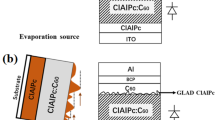Abstract
The open circuit voltage (V OC) of smallmolecule organic solar cells (OSCs) could be improved by doping suitable fluorescent dyes into the donor layers. In this paper, 4-(dicyanomethylene)-2-t-butyl-6-(1,1,7,7-tetramethyljulolidyl-9-enyl)-4H-pyran (DCJTB) was used as a dopant, and the performance of the OSCs with different DCJTB concentration in copper phthalocyanine (CuPc) was studied. The results showed that the V OC of the OSC with 50% of DCJTB in CuPc increased by 15%, compared with that of the standard CuPc/fullerene (C60) device. The enhancement of the V OC was attributed to the lower highest occupied molecular orbital (HOMO) level in the DCJTB than that in the CuPc. Also, the light absorption intensity is enhanced between 400 and 550 nm, where CuPc and C60 have low absorbance, leading to a broad absorption spectrum.
Similar content being viewed by others
References
Kim J Y, Lee K, Coates N E, Moses D, Nguyen T Q, Dante M, Heeger A J. Efficient tandem polymer solar cells fabricated by allsolution processing. Science, 2007, 317(5835): 222–225
Yu J S, Huang J, Zhang L, Jiang Y D. Energy losing rate and opencircuit voltage analysis of organic solar cells based on detailed photocurrent simulation. Applied Physics Letters, 2009, 106(6): 063103
Rider D A, Worfolk B J, Harris K D, Lalany A, Shahbazi K, Fleischauer M D, Brett M J, Buriak J M. Stable inverted polymer/fullerene solar cells using a cationic polythiophene modified pedot: pss cathodic interface. Advanced Functional Materials, 2010, 20(15): 2404–2415
Tang C W. Two-layer organic photovoltaic cell. Applied Physics Letters, 1986, 48(2): 183–185
Brabec C J, Sariciftci N S, Hummelen J C. Plastic solar cells. Advanced Functional Materials, 2001, 11(1): 15–26
Xue J, Uchida S, Rand B P, Forrest S R. 4.2% efficient organic photovoltaic cells with low series resistances. Applied Physics Letters, 2004, 84(16): 3013–3015
Wang N N, Yu J S, Zang Y, Huang J, Jiang Y D. Effect of buffer layers on the performance of organic photovoltaic cells based on copper phthalocyanine and C60. Solar Energy Materials and Solar Cells, 2010, 94(2): 263–266
Xue J, Uchida S, Rand B P, Forrest S R. Asymmetric tandem organic photovoltaic cells with hybrid planar-mixed molecular heterojunctions. Applied Physics Letters, 2004, 85(23): 5757–5759
Service R F. Solar energy. Outlook brightens for plastic solar cells. Science, 2011, 332(6027): 293
Coakley K M, Mcgehee M D. Conjugated polymer photovoltaic cells. Chemistry of Materials, 2004, 16(23): 4533–4542
Cheyns D, Rand B P, Heremans P. Organic tandem solar cells with complementary absorbing layers and a high open-circuit voltage. Applied Physics Letters, 2010, 97(3): 033301
Kinoshita Y, Hasobe T, Murata H. Control of open-circuit voltage in organic photovoltaic cells by inserting an ultrathin metal-phthalocyanine layer. Applied Physics Letters, 2007, 91(8): 083518
Chan M Y, Lai S L, Fung M K, Lee C S, Lee S T. S. L. Lai S L, Fung M K, Lee C S, Lee S T. Doping-induced efficiency enhancement in organic photovoltaic devices. Applied Physics Letters, 2007, 90(2): 023504
Wang N N, Yu J S, Lin H, Jiang Y D. Organic photovoltaic cells with improved performance using bathophenanthroline as a buffer layer. Chinese Journal of Chemical Physics, 2010, 23(1): 84–88
Taima T, Sakai J, Yamanari T, Saito K. Doping effects for organic photovoltaic cells based on small-molecular-weight semiconductors. Solar Energy Materials & Solar Cells, 2009, 93(6,7): 742–745
Cheyns D, Poortmans J, Heremans P, Deibel C, Verlaak S, Rand B P, Genoe J. Analytical model for the open-circuit voltage and its associated resistance in organic planar heterojunction solar cells. Physical Review B: Condensed Matter and Materials Physics, 2008, 77(16): 165332
Lai S L, Lo M F, Chan M Y, Lee C S, Lee S T. Lo M F, Chan M Y, Lee C S, Lee S T. Impact of dye interlayer on the performance of organic photovoltaic devices. Applied Physics Letters, 2009, 95(15): 153303
Mandoc M M, Veurman W, Koster L J A, de Boer B, Blom P W M. Origin of the reduced fill factor and photocurrent in MDMO-PPV: PCNEPV all-polymer solar cells. Advanced Functional Materials, 2007, 17(13): 2167–2173
Author information
Authors and Affiliations
Corresponding author
Rights and permissions
About this article
Cite this article
Li, Q., Yu, J., Zang, Y. et al. Enhancement of open circuit voltage in organic solar cells by doping a fluorescent red dye. Front. Energy 6, 179–183 (2012). https://doi.org/10.1007/s11708-012-0177-y
Received:
Accepted:
Published:
Issue Date:
DOI: https://doi.org/10.1007/s11708-012-0177-y




